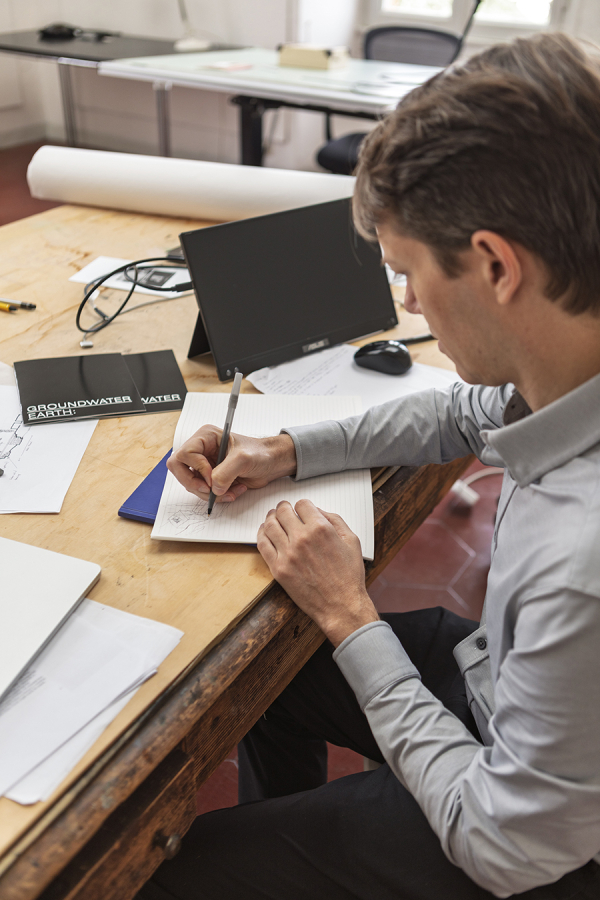Anthony Acciavatti, the Diana Balmori Assistant Professor for the Yale School of Architecture, is the 2025 Gilmore D. Clarke and Michael Rapuano/Kate Lancaster Brewster Rome Prize Fellow in landscape architecture. An architect, historian, and cartographer, Acciavatti studies the intersections of water, urbanism, and infrastructure across the globe. At AAR, he advanced his project Groundwater Earth: The World before and after the Tubewell, a sweeping investigation into how the widespread adoption of mechanized wells has reshaped human settlement, agriculture, and more. Building on his award-winning book Ganges Water Machine, the project draws from Acciavatti’s fieldwork in the Mediterranean and South and Southeast Asia to consider groundwater not only as an ecological concern but as a civic and spatial one.
AAR caught up with Acciavatti this month after completing his fellowship in January.
What did you work on while at AAR?
I spent my time at the Academy drawing and writing about humanity’s thirst for groundwater. We have extracted so much of it from the earth, largely through privately owned mechanized wells known as tubewells, that we have altered the tilt of the planet. While these wells number in the millions and have allowed billions of people to thrive, they also threaten to bleed the earth dry. The drawings and models I have been making that engage our reliance on tubewells will be shown at the Venice Biennale in May 2025 and at the Wellcome Collection in London in June 2025. For these exhibitions, I focus on thinking collectively about groundwater as a common resource in the same way we understand the air we breathe.
At the Academy I made progress on a book about how our species became so dependent on groundwater for drinking and irrigation. I focus on how cities, from Rome to New Delhi and Mexico City to Jakarta, depend on groundwater for their survival. Based on my work in the Mediterranean and in South and Southeast Asia, the book will conclude with how different systems of water management offer clues for better integrating groundwater as a collective resource to shape public space and life.
I also collaborated with my team at Ganges Lab, where we are developing much-needed public infrastructures along nalas (drains) across the Ganges River basin. We are finishing two papers as well as an animation and design proposals for sites along the Ganges.
Did your project change after arriving?
I originally came to Rome to study how the city depends on groundwater delivered to the city from aquifers in the Apennine Mountains. While I did investigate the ways Rome gives a civic dimension and monumentality to groundwater through its fountains and aqueducts, I ended up turning my focus to Venice’s wells. Nearly every piazza in Venice, a city situated in an estuary with little access to freshwater, is the roof of a sand-filled cistern that filtrates rainwater. This combination of public space (on the surface) and public infrastructure for drinking (in the subsurface) can teach us a great deal about sharing resources. I’m developing systems of collective rainwater capture and aquifer replenishment based on my study of Venice’s rainwater harvesting system for the Sonoran Desert and Indo-Gangetic plains.

What was your most surprising discovery?
I visited with a mentor, Jorge Silvetti (1986 Fellow), an unfinished nymphaeum by Donato Bramante, begun in the early sixteenth century for the Colonna family in Genazzano. The complex is fed by natural spring, which is to say groundwater, and the design is similar to the Baths of Diocletian in Rome. The arches and choreography of space and water are exquisite. The project was never completed and evidently served as a cattle shed and eventually a vegetable garden. I’m making drawings of the structure and water infrastructure.
How have your interactions with this year’s fellows and residents influenced your work or changed your perspective?
I found my most meaningful moments with fellows to be when we would serendipitously pass one another in the hallway or on the way to the market. These moments often led to conversations that extended over lunches and dinners at the Academy. Lasting friendships evolved from these interactions, and I imagine will continue far into the future.
What is coming up in the next few months, after your return home from Rome?
I am spending the rest of the academic year in India, where I will be an American Institute of Indian Studies Senior Fellow at Jamia Millia Islamia University in New Delhi. I will develop the drawings and models I began in Rome and write more of the book. There are archives and sites I need to visit in India, Indonesia, Bangladesh, and the Philippines.